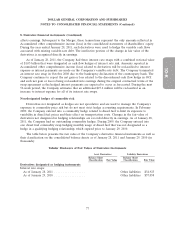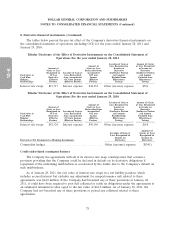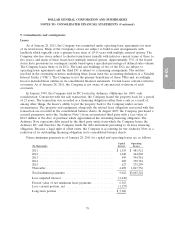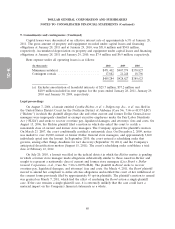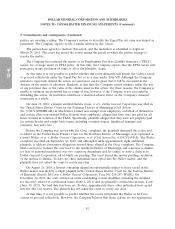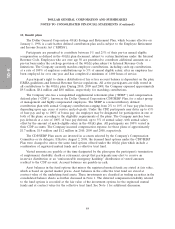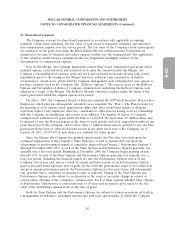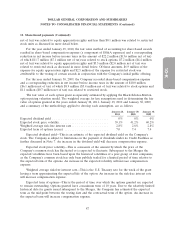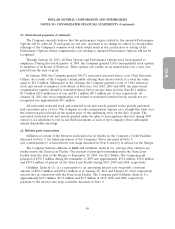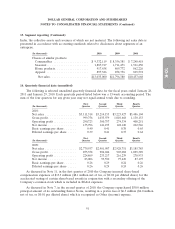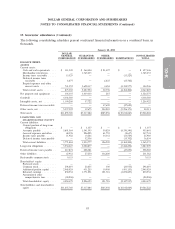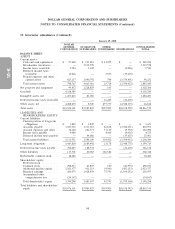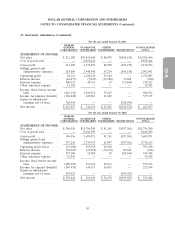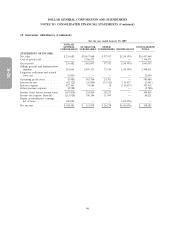Dollar General 2010 Annual Report Download - page 164
Download and view the complete annual report
Please find page 164 of the 2010 Dollar General annual report below. You can navigate through the pages in the report by either clicking on the pages listed below, or by using the keyword search tool below to find specific information within the annual report.
10-K
DOLLAR GENERAL CORPORATION AND SUBSIDIARIES
NOTES TO CONSOLIDATED FINANCIAL STATEMENTS (Continued)
11. Share-based payments (Continued)
may require the employee, upon termination, to sell to the Company any vested options or shares
received upon exercise of the Time Options or Performance Options at amounts that differ based upon
the reason for the termination. In particular, in the event that the employee resigns ‘‘without good
reason’’ (as defined in the management stockholder’s agreement), then any options whether or not then
exercisable are forfeited and any shares received upon prior exercise of such options are callable at the
Company’s option at an amount equal to the lesser of fair value or the amount paid for the shares
(i.e., the exercise price). In such cases, because the employee would not benefit in any share
appreciation over the exercise price, for accounting purposes such options are not considered vested
until the expiration of the Company’s call option, which is generally five years subsequent to the date
of grant. Accordingly, all references to the vesting provisions or vested status of the options discussed
in this note give effect to the vesting pursuant to these accounting provisions and may differ from
descriptions of the vesting status of the Time Options and Performance Options located elsewhere in
this report or the Company’s other SEC filings. The Company records expense for Time Options on a
straight-line basis over the term of the management stockholder’s agreement (generally five years).
Each of the Company’s management-owned shares, Rollover Options, and vested new options
include certain provisions by which the holder of such shares, Rollover Options, or vested new options
may require the Company to repurchase such instruments in limited circumstances. Specifically, each
such instrument is subject to a put right for a period of 365 days after termination due to the death or
disability of the holder of the instrument that occurs generally within five years from the date of grant.
In such circumstances, the holder of such instruments may require the Company to repurchase any
shares at the fair market value of such shares and any Rollover Options or vested new options at a
price equal to the intrinsic value of such Rollover or vested new options. Because the Company does
not have control over the circumstances in which it may be required to repurchase the outstanding
shares or Rollover Options, such shares and Rollover Options, valued at $8.8 million and $0.4 million,
respectively, at January 28, 2011, and $14.4 million and $4.1 million, respectively, at January 29, 2010,
have been classified as Redeemable common stock in the accompanying consolidated balance sheets as
of these dates. The values of these equity instruments are based upon the fair value and intrinsic value,
respectively, of the underlying stock and Rollover Options at the date of issuance. Because redemption
of such shares is uncertain, such shares are not subject to re-measurement until their redemption
becomes probable.
Subsequent to the Merger, the Company’s Board of Directors adopted an Equity Appreciation
Rights Plan, which plan was later amended and restated (as amended and restated, the ‘‘Rights Plan’’).
The Rights Plan provides for the granting of equity appreciation rights to nonexecutive managerial
employees. In 2009, the Rights Plan was modified such that certain equity appreciation rights vested as
a result of the Company’s initial public offering discussed in Note 2 that otherwise would not have
vested. At January 29, 2010, 697,762 equity appreciation rights were outstanding. During 2010, 783,322
equity appreciation rights were granted, 1,406,237 of such rights, affecting 1,028 employees, vested in
conjunction with the Company stock offerings, 21,557 of such rights vested as a result of other
provisions of the Rights Plan, 53,290 of such rights were cancelled and no such rights remain
outstanding at January 28, 2011.
For the year ended January 28, 2011, the fair value method of accounting for share-based awards
resulted in share-based compensation expense (a component of SG&A expenses) and a corresponding
reduction in net income before income taxes in the amount of $30.2 million ($18.4 million net of tax)
of which $12.7 million ($7.8 million net of tax) was related to stock options, $17.4 million ($10.6 million
86



